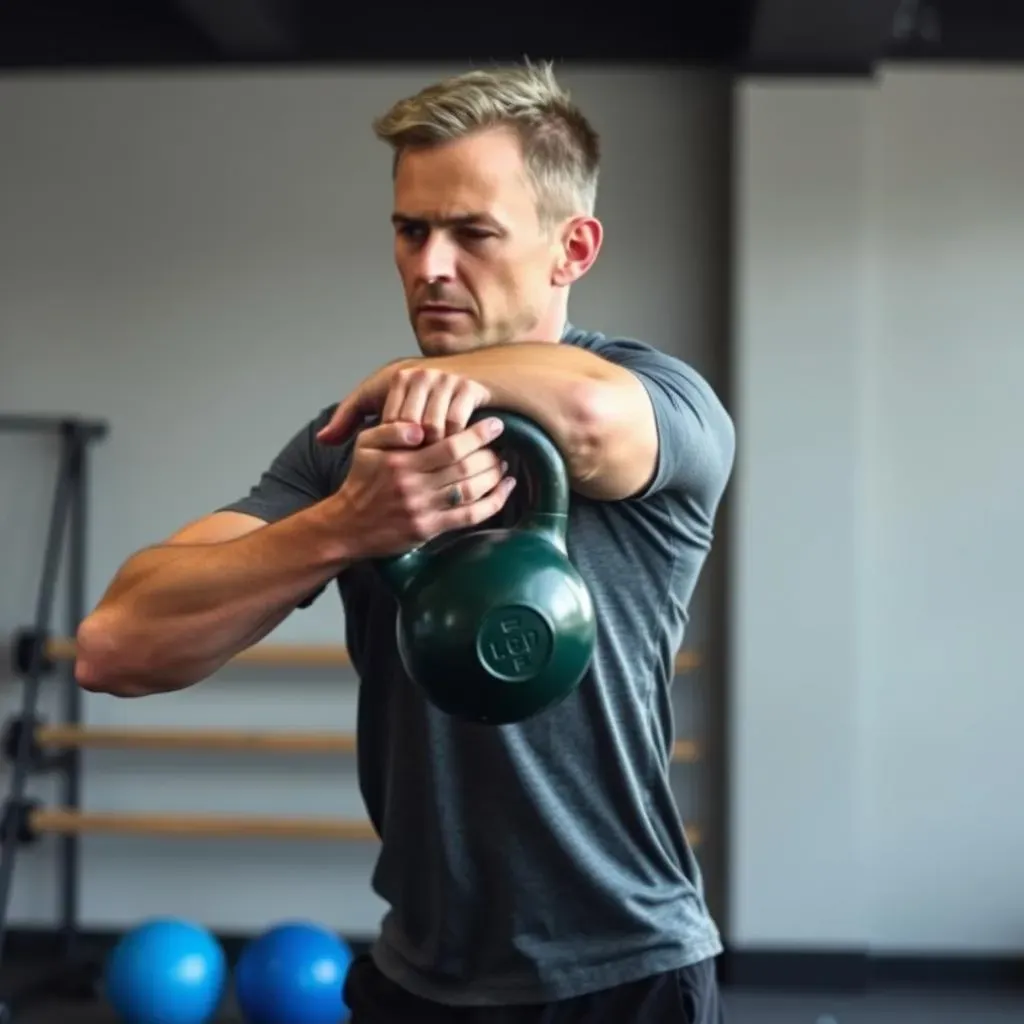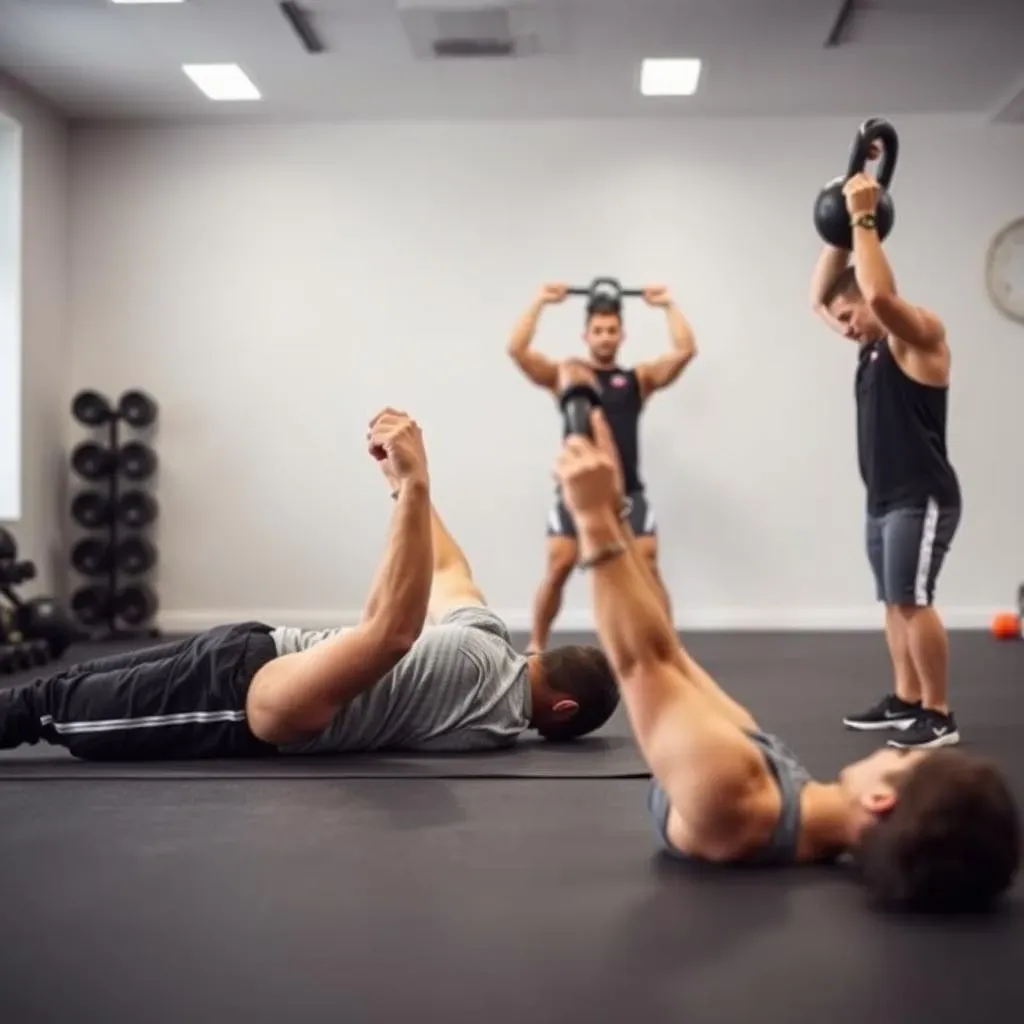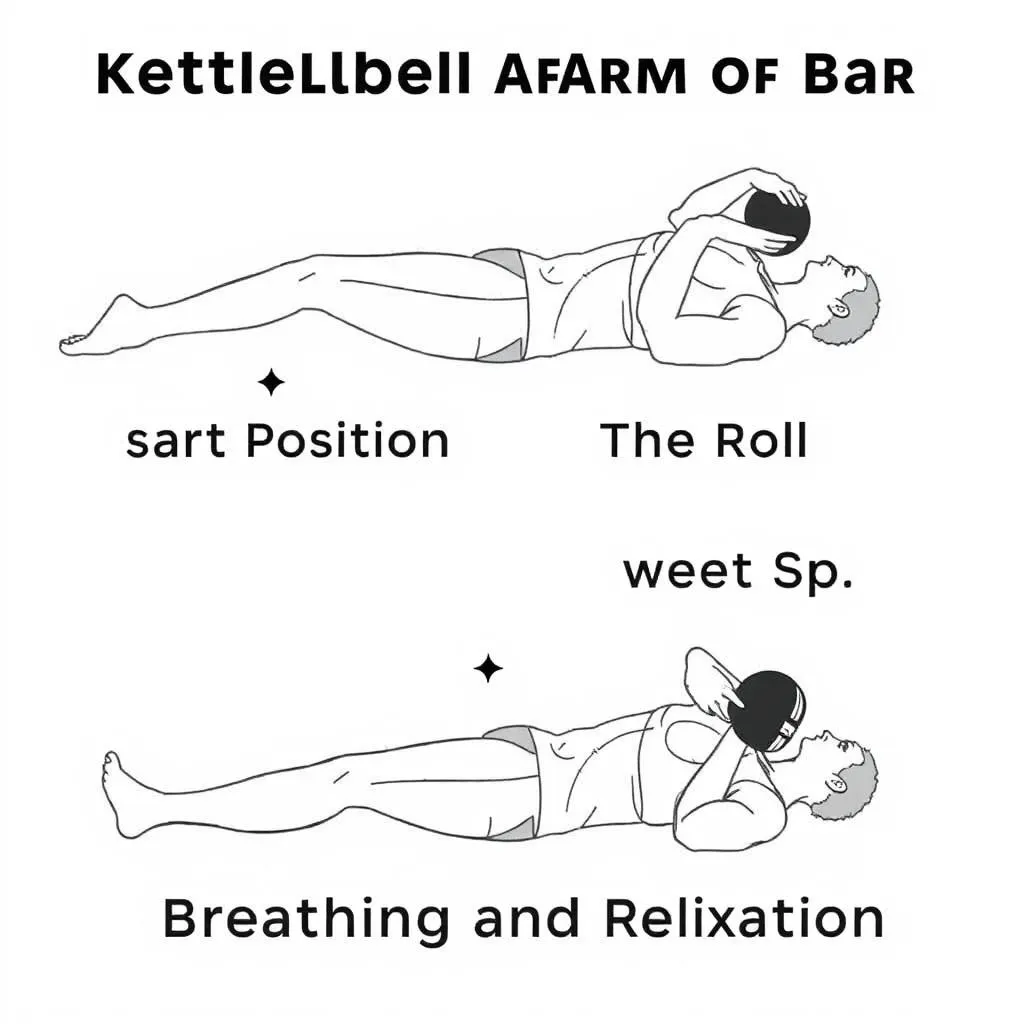Table of Contents
Are you battling stiff shoulders? Does everyday movement feel like a chore? You're not alone. Many people experience limited shoulder mobility due to sedentary lifestyles, poor posture, or old injuries. But there's a solution that combines strength and flexibility: kettlebell shoulder mobility exercises. Kettlebells aren't just for building muscle; they're fantastic tools for unlocking your shoulder's full range of motion, reducing pain, and improving overall function.
Why Kettlebell Shoulder Mobility Exercises Are a Game Changer

Why Kettlebell Shoulder Mobility Exercises Are a Game Changer
#1: Unlocking Pain-Free Movement
Let's face it: shoulder pain is a drag. It limits everything from reaching for that top shelf item to enjoying a simple game of catch. But what if I told you that kettlebell shoulder mobility exercises could be your ticket to a pain-free life? Unlike static stretches that only address muscle length, kettlebell movements dynamically improve joint function. They lubricate the joint, reduce stiffness, and restore a healthy range of motion. It's like giving your shoulders a much-needed oil change!
Think about it: how much time do you spend hunched over a desk or staring at your phone? This posture wreaks havoc on your shoulders, causing them to round forward and tighten up. Kettlebell exercises counteract these effects by strengthening the muscles that pull your shoulders back and down, promoting better posture and alleviating pain.
#2: The Power of Dynamic Mobility
Forget those static stretches you hold for what feels like an eternity. Kettlebell exercises are all about dynamic mobility, which means moving through a full range of motion with control. This approach not only improves flexibility but also enhances strength and stability. It's a win-win!
The beauty of kettlebells lies in their offset center of gravity. This unique design forces your muscles to work harder to control the weight, leading to improved proprioception (your body's awareness of its position in space) and enhanced joint stability. It's like training your shoulders to be more resilient and adaptable to different movements and loads.
Static Stretching | Dynamic Kettlebell Mobility |
|---|---|
Focuses on muscle length | Focuses on joint function and range of motion |
Primarily improves flexibility | Improves flexibility, strength, and stability |
Can sometimes decrease power output if performed before exercise | Prepares the body for movement and can enhance performance |
#3: Strength and Mobility: The Perfect Pair
Many people mistakenly believe that strength and mobility are separate entities. But the truth is, they're two sides of the same coin. You can't have one without the other. Kettlebell shoulder mobility exercises bridge this gap by simultaneously building strength and improving flexibility. It's like hitting two birds with one stone!
By strengthening the muscles surrounding the shoulder joint while also improving its range of motion, kettlebell exercises create a more balanced and resilient shoulder complex. This reduces the risk of injury and allows you to perform everyday activities with greater ease and confidence. Whether you're lifting groceries, playing sports, or simply reaching for something on a high shelf, strong and mobile shoulders will make your life easier.
- Reduced pain and stiffness
- Improved posture
- Enhanced range of motion
- Increased strength and stability
- Reduced risk of injury
Essential Kettlebell Exercises to Enhance Shoulder Mobility

Essential Kettlebell Exercises to Enhance Shoulder Mobility
#1: Kettlebell Arm Bar: Your Shoulder's Best Friend
The kettlebell arm bar is a game-changer for shoulder mobility. It gently opens up the shoulder joint, improves stability, and promotes healthy movement patterns. This exercise targets the often-neglected muscles around the shoulder blade, helping to restore proper alignment and function. Think of it as a reset button for your shoulders.
To perform the arm bar, lie on your back with a kettlebell extended towards the ceiling. Roll onto your opposite side, keeping the kettlebell arm straight. Use your free arm and leg to control your movement as you gently twist your torso, feeling a stretch in your shoulder. The key is to move slowly and deliberately, focusing on your breath and the sensation in your shoulder joint. This isn't about forcing anything; it's about gently coaxing your shoulder into a more mobile state.
#2: Kettlebell Halo: A Circular Symphony for Your Shoulders
The kettlebell halo is a fantastic exercise for improving shoulder mobility and stability in a circular motion. It challenges your rotator cuff muscles and enhances your body's awareness of your shoulder position in space. Plus, it's a great way to warm up your shoulders before more demanding exercises.
To perform the halo, hold a kettlebell upside down in front of your chest. Slowly circle the kettlebell around your head, keeping your elbows close to your body. Maintain a stable core and avoid shrugging your shoulders. Focus on controlled, deliberate movements, and breathe deeply throughout the exercise. You should feel a gentle stretch and activation in your shoulder muscles. If you experience any pain, stop immediately and reduce the range of motion.
Exercise | Benefits | Key Focus |
|---|---|---|
Kettlebell Arm Bar | Opens shoulder joint, improves stability, promotes healthy movement | Controlled twisting, gentle stretch |
Kettlebell Halo | Enhances circular mobility, challenges rotator cuff, improves proprioception | Stable core, controlled movements, deep breathing |
#3: Kettlebell Turkish Get-Up (TGU): The Ultimate Shoulder Mobility Challenge
The Turkish Get-Up (TGU) is a full-body exercise that demands exceptional shoulder stability and mobility. It involves transitioning from lying on the ground to standing upright while holding a kettlebell overhead. This exercise challenges your shoulder in multiple planes of motion, improving its strength, stability, and coordination. It's like a symphony of movement for your entire body, with your shoulder playing a starring role.
The TGU is a complex exercise that requires practice and patience. Start with a light kettlebell or even just your body weight. Break the movement down into smaller steps and master each one before progressing to the next. Focus on maintaining a stable shoulder position throughout the exercise, and avoid any jerky or uncontrolled movements. If you're new to the TGU, consider working with a qualified instructor to ensure proper form and technique. This can be a challenging exercise, but the rewards for your shoulder mobility are well worth the effort!
StepbyStep Guide to Performing Kettlebell Shoulder Mobility Drills

StepbyStep Guide to Performing Kettlebell Shoulder Mobility Drills
#1: Mastering the Kettlebell Arm Bar: A Detailed Walkthrough
Ready to unlock your shoulder's potential with the kettlebell arm bar? Here's a step-by-step guide to help you nail the technique and reap the rewards:
- Start Position: Lie on your back with your knees bent and feet flat on the floor. Hold a kettlebell in your right hand, extending it straight up towards the ceiling. Your left arm should be extended out to the side, palm facing up.
- The Roll: Keeping your right arm straight, roll onto your left side. Use your left arm and right leg to help control the movement. The goal is to gently twist your torso, feeling a stretch in your right shoulder.
- Finding the Sweet Spot: Once you're on your side, experiment with small adjustments to find the position that gives you the best stretch in your shoulder. This might involve slightly adjusting the angle of your torso or the position of your left arm and leg.
- Breathing and Relaxation: Focus on your breath throughout the exercise. Inhale deeply and exhale slowly, allowing your shoulder to relax and open up with each breath. Hold the position for 30-60 seconds, then slowly roll back to the starting position.
- Repeat: Perform 2-3 repetitions on each side. Remember, this isn't about forcing anything; it's about gently coaxing your shoulder into a more mobile state.
#2: Perfecting the Kettlebell Halo: A Comprehensive Guide
The kettlebell halo is a fantastic way to improve shoulder mobility and stability. Follow these steps to ensure you're performing the exercise correctly:
- Starting Position: Stand with your feet shoulder-width apart and hold a kettlebell upside down in front of your chest. Your elbows should be close to your body.
- The Circle: Slowly circle the kettlebell around your head, keeping your elbows close to your body. Maintain a stable core and avoid shrugging your shoulders.
- Controlled Movement: Focus on controlled, deliberate movements. Avoid any jerky or rushed motions. The goal is to maintain a smooth, fluid circle.
- Breathing: Breathe deeply throughout the exercise. Inhale as you move the kettlebell to the back of your head and exhale as you bring it back to the front.
- Direction: Perform the halo in both directions (clockwise and counterclockwise). Aim for 8-12 repetitions in each direction.
Step | Description | Key Focus |
|---|---|---|
1 | Start Position | Feet shoulder-width apart, kettlebell upside down in front of chest |
2 | The Circle | Slowly circle kettlebell around head, elbows close to body |
3 | Controlled Movement | Smooth, fluid motion, avoid jerky movements |
4 | Breathing | Inhale as kettlebell moves to back, exhale as it moves to front |
5 | Direction | Perform in both clockwise and counterclockwise directions |
#3: Breaking Down the Turkish Get-Up (TGU): A Step-by-Step Approach
The Turkish Get-Up (TGU) is a complex exercise that requires practice and patience. Here's a simplified breakdown of the movement:
- Starting Position: Lie on your back with your right knee bent and right foot flat on the floor. Hold a kettlebell in your right hand, extending it straight up towards the ceiling. Your left arm should be extended out to the side at a 45-degree angle, palm facing down.
- The Roll to Elbow: Keeping your right arm straight, roll onto your left elbow. Focus on maintaining a stable shoulder position throughout the movement.
- The High Bridge: Press through your right foot and left hand to lift your hips off the ground, creating a bridge position.
- The Sweep: Sweep your left leg back and underneath your body, placing your left knee on the floor behind you. You should now be in a lunge position with your right arm still extended towards the ceiling.
- The Stand: From the lunge position, stand up, maintaining a stable shoulder position and keeping your right arm extended.
- Reverse the Movement: Slowly reverse the movement, returning to the starting position one step at a time.
Remember to start with a light kettlebell or even just your body weight and focus on mastering each step before progressing to the next. If you're new to the TGU, consider working with a qualified instructor to ensure proper form and technique.
Integrating Kettlebell Shoulder Exercises into Your Routine and Avoiding Injury

Integrating Kettlebell Shoulder Exercises into Your Routine and Avoiding Injury
#1: Start Slow and Prioritize Form
Alright, you're pumped to add these kettlebell shoulder mobility exercises to your routine, which is awesome! But hold your horses, partner. The biggest mistake people make is jumping in too fast and too heavy. Remember, we're aiming for mobility and stability, not a PR on your snatch. Start with a light kettlebell – seriously light, like 8-12 lbs – or even just use bodyweight to master the movements. Form is KING (or QUEEN!). Focus on controlled, deliberate movements, and really pay attention to what your shoulder is telling you. If you feel any sharp pain, back off immediately. It's better to start slow and build a solid foundation than to rush in and end up sidelined with an injury.
Think of it like learning a new language. You wouldn't start by trying to write a novel, would you? No, you'd begin with the alphabet, then simple words, then short sentences. It's the same with kettlebell shoulder mobility. Master the basics, and the more advanced movements will come much easier.
#2: Warm-Up and Cool-Down: Shoulder's Best Friends
Never, ever skip your warm-up and cool-down. I cannot stress this enough. Your shoulders will thank you for it. A proper warm-up prepares your muscles and joints for the upcoming work, reducing the risk of injury. A good cool-down helps your body recover and prevents stiffness.
For your warm-up, try some light cardio, like arm circles, dynamic stretches, and maybe even a few bodyweight halos. The goal is to get the blood flowing and gently increase your range of motion. After your kettlebell session, spend some time stretching the muscles around your shoulder, like your pecs, lats, and traps. Hold each stretch for 30-60 seconds, and focus on relaxing and breathing deeply. Your shoulders will feel like they've just had a spa day!
Component | Description | Example |
|---|---|---|
Warm-Up | Prepares muscles and joints for exercise, reduces injury risk | Arm circles, dynamic stretches, bodyweight halos |
Cool-Down | Helps body recover, prevents stiffness | Static stretches (pecs, lats, traps), foam rolling |
#3: Listen to Your Body (Seriously!)
This might sound cliché, but it's crucial: listen to your body. Your body is a highly sophisticated instrument that is always communicating with you. The problem is, we're often too busy or distracted to listen. Pay attention to any pain, discomfort, or tightness in your shoulders. Don't push through pain; it's a sign that something is wrong. Modify the exercise, reduce the weight, or take a break if needed. There's no shame in scaling back; it's actually a sign of intelligence!
Also, be mindful of your posture throughout the day. Are you slouching over your desk? Are your shoulders rounded forward? Make a conscious effort to sit up straight, pull your shoulders back and down, and engage your core. Small changes in your daily habits can make a big difference in your shoulder health.
- Pay attention to pain, discomfort, or tightness
- Modify exercises as needed
- Prioritize good posture throughout the day
- Take breaks when necessary
Wrapping Up: Kettlebell Shoulder Mobility Exercises for a Healthier You
Incorporating kettlebell shoulder mobility exercises into your fitness routine can be a game-changer for improving your range of motion, reducing pain, and enhancing overall shoulder health. Remember to start slow, focus on proper form, and listen to your body. Consistency is key, so aim to gradually increase the intensity and duration of your workouts. With dedication and the right approach, you'll be well on your way to unlocking your shoulders' full potential and enjoying a more active, pain-free life. So grab a kettlebell and start moving towards a healthier, more mobile you today!